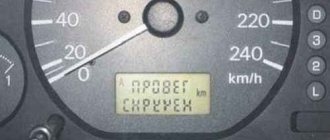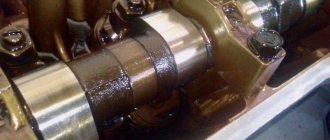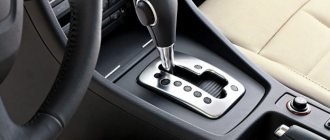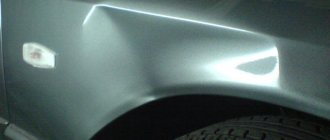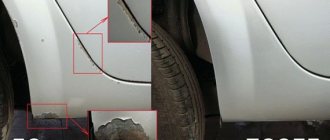No comments
Rating:
Buying a used car comes with the risk of receiving a product with a twisted speedometer. Even if the buyer has considerable experience in identifying age-related problems in a car, the danger of being deceived remains.
Let's consider several proven methods by which you can determine the mileage of a car exceeding 200 thousand kilometers.
ECU log
Many drivers know how the mileage on a mechanical odometer is calculated. After removing the panel, you need to connect an electric motor to the cable (a screwdriver or drill will do). Turn on reverse rotation and unscrew the required number of kilometers.
The electronic odometer is adjusted using a scanner and a laptop connected to the ECU. The data is erased, but in modern cars a log file with real mileage indicators remains in the memory of the control unit.
So how do you find out the actual mileage of a car?
Experienced and knowledgeable people do not simply allow themselves to be deceived and can find fault with anything. For example, if the declared mileage of a car is 70 - 100 thousand km, then there should be subtle abrasions and possibly scratches in the interior, depending on how the previous owner treated it. However, there should be no obvious holes in the fabric, faded paint, etc. The appearance of the car, both inside and outside, must fully correspond to the stated figures on the odometer. Only in this case can you hope that you are buying a car with the specified mileage, and that it will serve you for many more years.
Body
The condition of the paintwork can accurately indicate the age of a car if:
- the paint on horizontal planes has changed color under the influence of the sun;
- wheel arches and sills were badly damaged by the sandblasting effect of gravel and sand flying out from under the wheels at speed;
- rust in areas where water most often retains.
Skoda Octavia 2.0 TDI 2004
Mileage: 500,000 km.
Our colleagues from the Czech magazine “Auto TIP” told us details about this car. They recently managed to inspect an Octavia II 2.0 TDI with a 200,000 km mileage. During the examination, it turned out that the car had a mileage of 500,000 km. It is worth noting that by examination we mean the complete disassembly of the car for parts, with the study of the condition of the car.
The car was almost always used mainly on one route - between the Czech Republic and Slovakia.
At first glance, Octavia looked good. Several elements were broken in the cabin: light switch, window control buttons. During the inspection, blue smoke was noticed from the exhaust pipe, there were problems with starting the engine, the whistling of the turbine was heard (but the power was normal!), wear on the cylinder head, worn suspension components and brakes.
Bottom line: despite the problems, this car can still serve after a series of repairs. So if you find a diesel Skoda Octavia with 300,000 km (real) mileage, then have no fear. This is a tough car.
Salon
Interior elements can indicate the real age of the car:
- The pedal pads and the driver's foot mat are subject to the greatest stress. Therefore, by 200 thousand mileage the pedals are polished to a shine. But if the buyer sees new rubber bands and floor mats, it’s worth thinking about the age of the car.
- The upholstery, gearshift lever and steering wheel wear out within 100,000 years, so it is unlikely to hide this defect. When, when buying a used car, a car enthusiast sees a new steering wheel and a reupholstered interior, he should ask the seller questions.
Factors that affect machine wear
How far the car traveled on its journey depends on the following factors:
- brand and country of manufacturer;
- the roads along which the car moved;
- Terms of Use;
- driving style and driver care.
There is no clearly defined limit on what mileage you should buy a car with, and what mileage on the speedometer is considered normal. When choosing a second hand car, it is worth comparing the mileage with the year of manufacture, but it often happens that a young and inexperienced driver with minimal mileage in a year ends up in so many accidents that the car is no longer possible to drive. Therefore, the car is brought back to normal on the outside and sold at a high price, because the mileage is not high.
Also, you can meet a real caring driver who blew away specks of dust from his “companion”. His fifteen-year-old car may look better than from the showroom, but the mileage will be impressive.
The country in which the car is made also plays a role. Despite the fact that Chinese cars have almost completely flooded the Russian markets, they do not inspire confidence enough to buy with high mileage. Often Chinese cars work normally for as long as the warranty is provided.
Most often, the electronics are the first to fail, after which the body and chassis begin to fall apart. The situation is somewhat different with the same German cars, which will confidently cover hundreds of kilometers and will last for many years with proper operation.
Bottom
Proven long mileage marker. This is especially noticeable on large all-wheel drive models that are purchased for long trips and business trips.
Crossing the 100-200 thousand mark will be marked on the bottom of the car with “sandblasting” gravel stripes.
If the bottom is covered with fresh paint, or some other type of protection, it indicates the real age of the car.
See also:
How and what to treat the underbody of a car
Nuances when choosing your first used car
Checking the mileage and condition of the car as a whole, especially if this is your first car, can be entrusted to friends who deal with cars by profession, or to experienced drivers who are aware of all things. If you don’t have such friends and you need to rely only on yourself, then after checking the declared mileage on the meter, you need to look at the car’s pedals. It is by the pedals that you can determine how long the car has been in use. If the odometer shows 50 thousand km, and the pedals have very rough abrasions and worn out rubber pads, then you should think about it. Likewise, it's worth considering if these pads are completely new. You definitely need to ask the seller the reason for the replacement and, if he hesitates, you can move straight to the next check, making sure to note in your head that the price of this car can already be significantly reduced. An important next factor in checking a car's mileage is the steering wheel. The ideal option is a leather steering wheel. Changing the upholstery of a leather steering wheel is very expensive, and it is almost impossible to reupholster it to match the “original”. So the quality of the surface, the wear of the buttons, and the wear of the upholstery itself clearly indicate the actual mileage of the car.
The next important stage of inspection is seat upholstery. The general level of wear on the seats, steering wheel, and pedals simply must be the same, otherwise this is another reason to bargain and bring down the price by asking: “Why were the seats/steering wheel changed?”
When a car's mileage is 100,000 - 120,000 km, the fabric on the seats fades and becomes combed, and the same problem occurs with leather. Some sellers turn to chemical cleaners to get rid of stains and give the salon a cosmetic appearance. cleaning, but usually this is only for general appearance. You can easily look under the seat, or move it back and lift it up to see how the color texture and wear differ from the surface.
Choosing your first used car is not limited to just looking at its meter. Each party (seller/buyer) is looking for benefits for itself. You should focus on the car’s normal mileage of 20-30 thousand kilometers per year, but you have to find out how it was treated all this time. The choice should be based on your own knowledge and a thorough check of the car as a whole. Only then can you guarantee yourself the choice of an inexpensive, good car that will serve you for a very long time.
Timing belt
For modern cars, the timing of replacing the timing belt does not exceed 70 thousand kilometers.
It is necessary to pay attention to the condition of the belt, its manufacturer and tension. Towards the end of the service life of the gas distribution mechanism drive, it shows signs of stretching.
See also:
Local car record: A Toyota with one and a half million miles is sold on Avito
When buying a car, you need to be guided not only by the visual determination of its mileage. You should ask the owner about the service book, which indicates the mileage and the number of repairs to the main components of the car. In this way, you can protect yourself from the actions of scammers.
Resource is measured in engine hours
Buyers determine the condition of used cars by the number of kilometers traveled and by the lifespan they have lived. This is true for the body, since high mileage on the odometer and advanced age result in metal fatigue and the appearance of cracks on the shock absorber cups and at the base of the body struts. However, the technical part of the machine when assessing the residual life is characterized by another metric: engine hours. They calculate the life of the power unit and gearbox.
On average, manufacturers expect the engine to operate for 5,000 hours, after which a major overhaul is required. In general, with normal driving at a speed of 60 km/h without congestion, with good engine cooling and without serious loads, 15 thousand kilometers are equal to 250 engine hours. From this indicator the service interval is calculated. Modern synthetic oil can operate up to 300 hours.
Article on the topic
False misconceptions. What should you not be afraid of when buying a used car? If the car “lives” in a big city, then it will cover the daily journey from home to work not in half an hour, as required by mileage, but in an hour or even two. Moreover, in the summer you have to “boil” the engine and overheat it in traffic jams. The resource of the power unit decreases.
Frequent cycles of starts and stops in summer traffic jams generate even more engine hours than driving on highways at a constant speed.
Already after 7 thousand kilometers in city traffic jams, the engine can produce 300 operating hours. And at 15 thousand it approaches 500-600 engine hours. Naturally, if you don’t change the oil and wait until the end of the scheduled interval of 15 thousand kilometers, then the entire second half of the year the engine runs for wear on used oil.
In general, a power unit that is often forced to work in traffic jams needs to be serviced twice as often. The oil in it should be changed not after 15 thousand kilometers, but after 7 thousand.
Saab SPG
Year of manufacture: 1989 Mileage: 1,611,573 kilometers Long-distance runs best suit the profession of a traveling salesman. It was mobile trading that Peter Gilbert did in his 1989 Saab SPG coupe (factory tuning from Special Performance Group). The owner donated his partner to a car museum in the small town of Hartford in 2006, after putting 1,001,385 miles on it over 17 years. During this time, the Saab wore out 88 tires, three head gaskets and one gear. The engine and turbocharger of this car are original, but the body is not in very good condition due to driving on winter roads treated with salt.
Applicability on cars
Budget car models Renault Logan 1.4 and Logan 1.6 have managed to win the recognition of many thousands of car enthusiasts over their almost ten-year history of presence on Russian roads.
The concept of the French manufacturer, which decided back in 1998 to create an inexpensive and practical passenger car intended for developing markets, received the most triumphant continuation and unexpected development in Russia. If in 2005 it all began at a small site of the Avtoframos enterprise in Moscow with the “screwdriver” assembly of several thousand cars per month, then today the Volzhsky Automobile Plant is building its annual plans, relying on the whole “Loganov” model scattering: Renault Logan, Renault Sandero, Lada Largus. Sales of these three models in the country in 2014 exceeded 160 thousand units.
To a large extent, such popularity of these Renault models was ensured by the use of proven and well-proven 8V single-shaft internal combustion engines (ICE) of the K7J 1.4 l and K7M 1.6 l series as power units. The flagship of the line for Renault Logan is considered to be a 16V four-cylinder liquid cooling unit with the index K4M, the production of which, in addition to the parent company Renault Espana, is also mastered at AvtoVAZ production sites.
Control questions
- What is the technical readiness coefficient of the fleet and how is it determined?
- What is the fleet utilization rate?
- How is the working time utilization factor determined?
- What is technical and operational speed?
- What are the different types of car mileage?
- What is mileage utilization rate?
- How is the utilization rate of a vehicle's carrying capacity determined?
"Car", under. ed. I.P. Plekhanov

